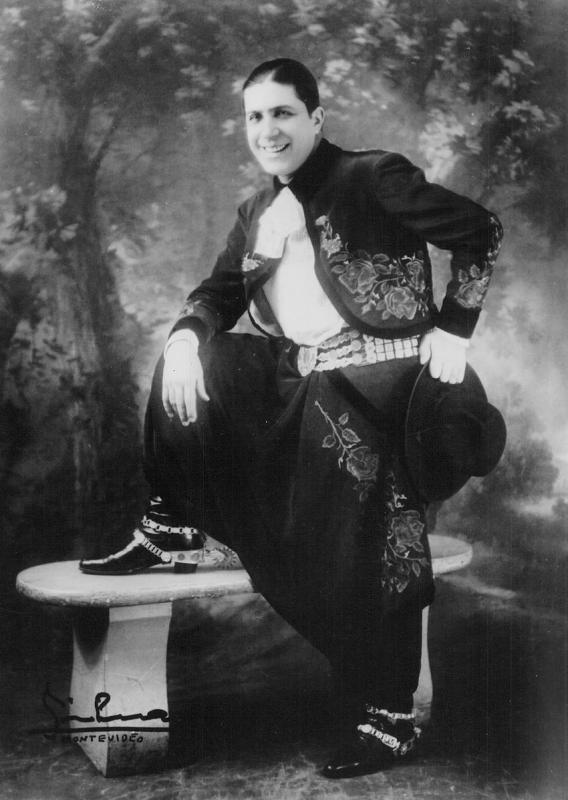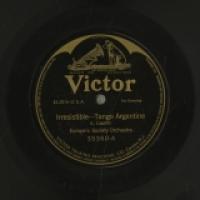Carlos Gardel
PerformerA recording artist of the 1920s and early 1930s, the Argentine tango singer Carlos Gardel was a massive, international star who is still a beloved figure today. His career exemplifies both the power and the limits of early-twentieth-century globalization: he recorded for the multinationals Victor, Columbia, and Odeon, and he became a movie star in films made by the Hollywood studio, Paramount. Nevertheless, the peak of his career coincided with a moment in which the global recording industry was establishing genres that were strongly linked to national or ethnic identities. Gardel became a household name throughout Latin America but was virtually unknown in the United States.
Born in Toulouse, France (his surname is a Hispanization of Gardès), Gardel emigrated to Argentina with his impoverished mother at the age of two. During the 1910s, he emerged as one half of the Gardel-Razzano singing duo, which specialized not in tango, but in folk genres associated with the rural world of the pampas. Accompanied by guitars, Gardel and Razzano performed music that belonged to the hugely popular genre of "criollismo," a theatrical and literary form that celebrated the rustic lives of the gauchos of the Argentine and Uruguayan pampas.
In 1917, Gardel recorded his first tango, "Mi noche triste" by Pascual Contursi. The recording made little impact at first, but the following year, "Mi noche triste" was included in a popular play. The song, and particularly Gardel's recording of it, was now a hit. Over the next several years, tangos would increasingly dominate Gardel's repertoire. As a genre of songs that developed in tandem with the popular theatre, the tango featured melodramatic stories of love and betrayal set in the "arrabales," the working-class neighborhoods on the outskirts of Buenos Aires, and featuring tough guys called "compadritos" and dancing girls called "milonguitas."
Gardel developed a highly emotional singing style with a distinctive, almost conversational approach to phrasing that relied heavily on rubato, a technique in which the performer avoids strict adherence to the tempo, slowing down and speeding up the melody to heighten emotional expression. This style would have a powerful impact not only on generations of tango singers but on composers and musicians as well.
Beginning in 1931, Gardel starred in eight full-length movies produced by Paramount, the first four filmed in France and the last four in the United States. These films reflected an effort by the Hollywood studio to tap into the Spanish-language market for sound films. They were musicals with flimsy romantic plots designed to give Gardel lots of opportunities to sing and to appear in his trademark tuxedo. Most of them were loose variations on his own biography; typically, he played a poor boy who becomes a hugely successful tango star. The films had an enormous impact on the nascent film industry in Argentina, encouraging a whole subgenere of tango movies. Beyond Argentina, they extended the popularity of tango and made Gardel a star throughout the Spanish-speaking world.
Gardel died in a plane crash in Medellín, Colombia in 1935.
Born in Toulouse, France (his surname is a Hispanization of Gardès), Gardel emigrated to Argentina with his impoverished mother at the age of two. During the 1910s, he emerged as one half of the Gardel-Razzano singing duo, which specialized not in tango, but in folk genres associated with the rural world of the pampas. Accompanied by guitars, Gardel and Razzano performed music that belonged to the hugely popular genre of "criollismo," a theatrical and literary form that celebrated the rustic lives of the gauchos of the Argentine and Uruguayan pampas.
In 1917, Gardel recorded his first tango, "Mi noche triste" by Pascual Contursi. The recording made little impact at first, but the following year, "Mi noche triste" was included in a popular play. The song, and particularly Gardel's recording of it, was now a hit. Over the next several years, tangos would increasingly dominate Gardel's repertoire. As a genre of songs that developed in tandem with the popular theatre, the tango featured melodramatic stories of love and betrayal set in the "arrabales," the working-class neighborhoods on the outskirts of Buenos Aires, and featuring tough guys called "compadritos" and dancing girls called "milonguitas."
Gardel developed a highly emotional singing style with a distinctive, almost conversational approach to phrasing that relied heavily on rubato, a technique in which the performer avoids strict adherence to the tempo, slowing down and speeding up the melody to heighten emotional expression. This style would have a powerful impact not only on generations of tango singers but on composers and musicians as well.
Beginning in 1931, Gardel starred in eight full-length movies produced by Paramount, the first four filmed in France and the last four in the United States. These films reflected an effort by the Hollywood studio to tap into the Spanish-language market for sound films. They were musicals with flimsy romantic plots designed to give Gardel lots of opportunities to sing and to appear in his trademark tuxedo. Most of them were loose variations on his own biography; typically, he played a poor boy who becomes a hugely successful tango star. The films had an enormous impact on the nascent film industry in Argentina, encouraging a whole subgenere of tango movies. Beyond Argentina, they extended the popularity of tango and made Gardel a star throughout the Spanish-speaking world.
Gardel died in a plane crash in Medellín, Colombia in 1935.



